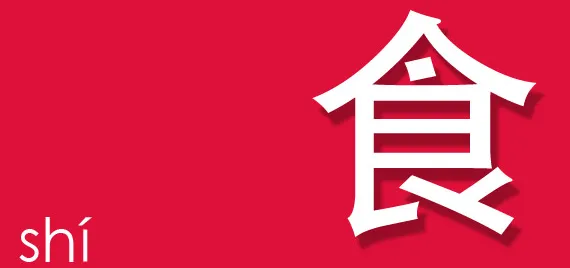The combinations of and variations on this food-related character are as abundant and creative as Chinese cuisine itself
食 means food. When guests are invited to a Chinese home for a meal, it is the host’s duty to prepare extra food and send everyone home with a stuffed belly. Perhaps this is why the original oracle bone inscriptions of the Chinese word for food, 食 (shí), depicted a cooking vessel with its contents spilling beyond the confines of its lid. As the Chinese script continued to evolve into China’s Bronze Age, however, the lower portion of 食 was tidied up and revised to fit neatly within its so-called lid. Later, when the Qin Dynasty (221 – 206 BCE) standardized script got hold of this food character, 食 was given a fork for legs. This style remained an influence through the Han Dynasty’s (206 BCE – 220 CE) official script and the fork legs are still evident in the character’s modern day representation.
Since the day 食 was first cracked into a tortoise shell, the character has always been related to food. The point of food, of course, is to eat it. Therefore, 食 is also used to describe the act of eating, snacking, feasting, you name it. A study of the oracle bone inscriptions reveals the words “大食” (dàshí) and “小食” (xiǎoshí), which indicates that the ancient Chinese allotted themselves two meals a day. Breakfast was called “大食” and the afternoon meal was referred to as “小食.”
The use of 食 is not limited to human or animal activities of nourishment, however. The ancient Chinese perceived a solar eclipse to be the result of some greater beast engulfing the sun, thus coining the term “日食” (rìshí), and the same logic was applied to the inexplicable consuming of the moon, “月食” (yuèshí, lunar eclipse).
There are endless combinations of characters that employ 食 as a symbol for food or its consumption. “主,” which means “main”, paired with “食” refers to the staple food (主食 zhǔshí ), such as rice, noodles or bread. “丰衣足食” (fēngyī zúshí) indicates a person who is well-fed and well-clothed; “饥不择食” (jībùzéshí) translates as “beggars can’t be choosers” but literally means “the starving can’t choose what they eat”; and the phrase “民以食为天” ( mín yǐ shí wéi tiān) characterizes the masses that regard sufficient food as the ultimate life necessity.
Molding 食 into verb form has also supplied the Chinese language with a vibrant array of vocabulary. Resembling 欲望 (yùwàng), the word for desire, “食欲” (shíyù) describes the desire to eat food—in other words, to have an appetite. “食草动物” (shí cǎo dòngwù) refers to animals that eat vegetation, also known as herbivores. “废寝忘食” (fèiqǐn wàngshí) means to be so absorbed in a task that one forgets to sleep and eat. “虎毒不食子” (hǔ dú bù shí zǐ) explains that even ferocious tigers do not eat their young—all men, good or bad, are incapable of mistreating their own children.
While 食 is generally paired with edibles, the character is not always applied literally. For example, how is it possible for a person to eat words (言 yán), as described in the Chinese idiom “those who eat their words are fat” (食言者肥 shíyán zhě féi)? As it turns out, “食言” means an unfulfilled promise, as if the words have been eaten and the promise no longer exists. Therefore, a person who frequently seeks profit at another’s expense is consequently a fat person who excessively consumes his or her wordy promises.
In classical Chinese, 食 can also be read as “sì,” which means to provide food for others. Classical literature contains the saying, “解衣衣人,推食食人”(Jiě yī yì rén, tuī shí sì rén), which instructs man to disrobe himself in order to dress others and refuse food in order to feed others. However, this variant form of “食” has long since fallen out of usage.
Moreover, using “食” as a verb is too archaic for today’s colloquial tongue. Instead,the action word en vogue is “吃.” In modern Chinese, you “吃奶 (chīnǎi, suck the breast), 吃药 (chīyào, consume medicine),吃醋 (chīcù, literally, “eat vinegar”—used as “be jealous”),吃零食 (chī língshí, eat snacks),大鱼吃小鱼 (dàyú chī xiǎoyú, literally, “the big fish eat the little fish”—used as “the strong bully the weak”), and so on. Nevertheless, modern written Chinese still applies “食” to describe the act of eating. For example, 蚕食 (cánshí, literally, “silkworm eats”—used as “to nibble”), 禁食 (jìnshí, literally, “prohibited to eat”—used as “religious fasting”), 美食家 (měishíjiā, “beautiful food expert,” which refers to “gastronome,” “food critic,” “dietician”), 饮食起居 (yǐnshí qǐjū, daily life), 不食人间烟火 (bù shí rénjiān yānhuǒ, literally, “does not eat the human world’s food”—used as “otherworldly being”), and the list goes on…
Besides representing words that indicate food or eating, “食” is also administered as a radical for other food-related words, including “饭 (fàn, rice; food), 饼 (bǐng, cracker; cake; cookie), 馍 (mó, steamed bun), 馅 (xiàn, stuffing; filling), 饺 (jiǎo, dumpling), 餐 (cān, meal), 馋 (chán, gluttonous), 饱 (bǎo, be full), 饥饿 (jī’è, hungry).” Occasionally, “食” is used as a phonetic element to indicate the pronunciation of a character, such as “饰” (shì), in which “食” appears as the left-side radical. However, “饰” means to decorate or impersonate and thereby has nothing really to do with food or eating. The real relationship is in the marginally distinguishable readings of the words, 食 vs. 饰. Now, don’t be confused by the extremely simplified “饣” radical posing as 食. In traditional characters, the Chinese take the time to write out the nearly complete radical version of “食” as “飠”. However, influenced by Chinese cursive handwriting, the “食” radical has also appeared written as “饣” as early as the Han Dynasty.
Now for a test of will and intellect: How long can you sit creating a list of words incorporating the character “食” before you get hungry for a full 餐 or a sweet 饼?
Translated by Caroline Berg (碧琪莲)














